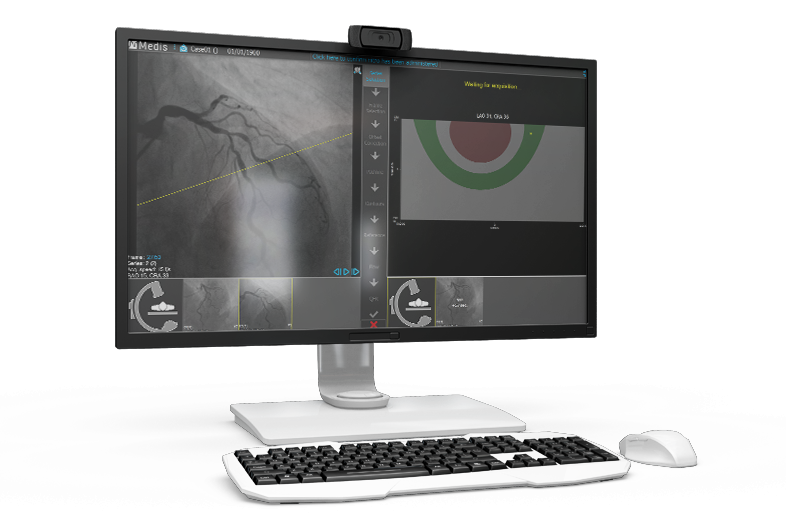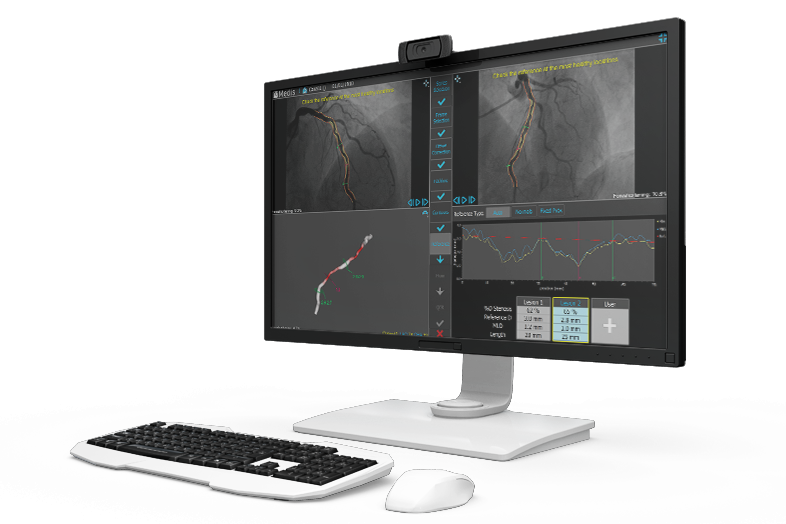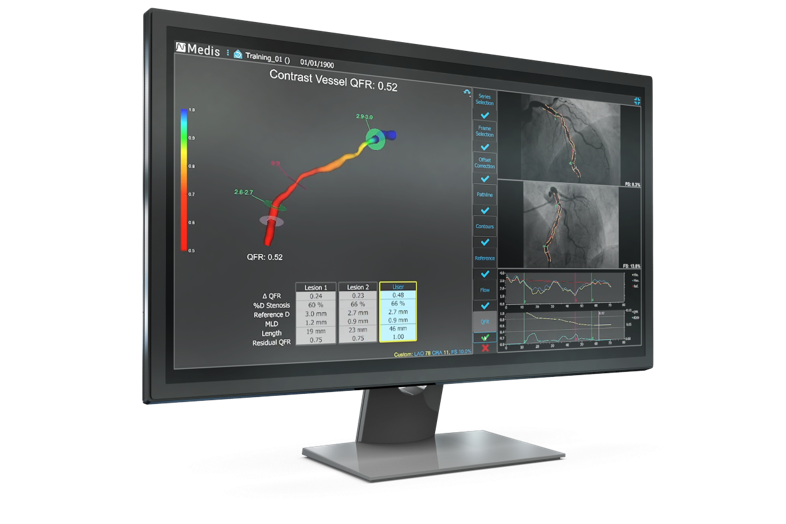Medis QFR®, the most scientifically proven, image-based functional assessment of coronary obstructions from coronary angiograms, is our software solution that offers a simple, intuitive workflow, applicable for both real time analysis in the Cath lab and deferred assessment.
Assess coronary lesions with QFR®’s fast and precise analysis, ensuring both efficiency and precision in decision-making.

Assess coronary lesions with QFR®’s fast and precise analysis, ensuring both efficiency and precision in decision-making.

Assess coronary lesions with QFR®’s fast and precise analysis, ensuring both efficiency and precision in decision-making.

Simpler Intuitive workflow, applicable for online and offline usage
Lorem ipsum dolor sit amet, consectetur adipiscing elit. Ut elit tellus, luctus nec ullamcorper mattis, pulvinar dapibus leo.
Lorem ipsum dolor sit amet, consectetur adipiscing elit. Ut elit tellus, luctus nec ullamcorper mattis, pulvinar dapibus leo.
Upcoming events
23-10-2023 – 26-10-2023
Medis is joining the TCT 2023 in San Francisco. We will be showcasing the latest advancements in Medis QFR®, our software solution for image-based coronary physiology. During the TCT we will be hosting a symposium on Non-Invasive Physiological Approaches to Epicardial and Microvascular Disease in the Cath Lab.

QFR® simplifies image acquisition. It requires just two angiograms and works with most major vendors. Whether your lab uses monoplane or biplane systems, QFR® seamlessly integrates, adapting to your clinical needs. Forget manual calibration – QFR® automates this process, saving valuable time for cardiologists. Additionally, our patented acquisition guiding tool ensures you capture high-quality images at optimal angles, boosting the accuracy of QFR® analysis. This empowers clinicians to make informed decisions for better patient outcomes.
Automated calibration based on Isocenter data, Medis QFR® offers two distinct flow models
Contrast QFR® which utilizes contrast frame count, provides a convenient and efficient method for calculating flow velocity. Whether using automatic or manual frame counting, interventional cardiologists can accurately assess flow velocity during angiography. This feature simplifies the process of obtaining flow data for QFR analysis, saving time and ensuring precise evaluation of lesion severity. It enhances the overall workflow and equips interventional cardiologists with valuable information to make informed treatment decisions with confidence.
QFR’s fixed flow velocity approach guarantees consistent and standardized flow conditions for accurate lesion assessment. Through the use of a fixed flow, interventional cardiologists can achieve reliable and reproducible QFR measurements, enabling precise evaluation of lesion severity and facilitating effective treatment planning. This feature enhances the overall accuracy and reliability of QFR analysis, empowering clinicians to make well-informed clinical decisions for optimal patient care.


The pressure drop is color coded. A normal flow is displayed in blue / green while a reduced flow is displaced in orange / red color.
– Changes of QFR value compared to reference vessel
– Percent Diameter Restenosis
– Reference Diameter
– Minimum Lumen Diameter(MLD)
– Length of Lesion
QFR® Pullback Curve provides Pressure drop values along the entire segment
Residual QFR® predicts the effect of an intervention on the resulting QFR® value
Assess coronary lesions with QFR®’s fast and precise analysis, ensuring both efficiency and precision in decision-making.

Assess coronary lesions with QFR®’s fast and precise analysis, ensuring both efficiency and precision in decision-making.

Assess coronary lesions with QFR®’s fast and precise analysis, ensuring both efficiency and precision in decision-making.

You are only a click away from having your demo with an experienced Medis QFR® product specialist.
Coronary angiography is an imaging defined as the radiographic visualization of the coronary vessels after injection of radiopaque contrast media. It’s usually done using special catheters during cardiac catheterization, which can also involve imaging other blood vessels like the aorta and left ventricle. The resulting X-ray images, known as angiograms, play a crucial role in assessing the degree of luminal obstruction of the coronary arteries. While coronary angiography is versatile and can be applied to different areas of the body, it’s particularly vital when it comes to evaluating the arteries of the heart.
A coronary angiogram specifically focuses on the arteries in the heart. This procedure provides a detailed X-ray view of these arteries, offering valuable insights into the presence and severity of heart disease. It serves as a fundamental tool for determining the overall functionality of the heart.
The Role of Coronary Angiography in Treatment Decisions
Once a coronary angiogram is performed, the gathered information becomes instrumental in guiding treatment decisions. Coronary angiography is a pivotal diagnostic tool in interventional cardiology, allowing to assess the degree of arterial narrowing and determine the need for further interventions. Armed with this information, interventional cardiologists can collaborate with patients to determine the most appropriate treatment plan, which may include stent placement, bypass surgery, or medication. Understanding the significance of coronary angiography empowers healthcare professionals to make informed decisions that improve patient outcomes in the field of interventional cardiology.
Reference
https://www.ahajournals.org/doi/pdf/10.1161/01.cir.99.17.2345
Coronary angiography is an imaging defined as the radiographic visualization of the coronary vessels after injection of radiopaque contrast media. It’s usually done using special catheters during cardiac catheterization, which can also involve imaging other blood vessels like the aorta and left ventricle. The resulting X-ray images, known as angiograms, play a crucial role in assessing the degree of luminal obstruction of the coronary arteries. While coronary angiography is versatile and can be applied to different areas of the body, it’s particularly vital when it comes to evaluating the arteries of the heart.
A coronary angiogram specifically focuses on the arteries in the heart. This procedure provides a detailed X-ray view of these arteries, offering valuable insights into the presence and severity of heart disease. It serves as a fundamental tool for determining the overall functionality of the heart.
The Role of Coronary Angiography in Treatment Decisions
Once a coronary angiogram is performed, the gathered information becomes instrumental in guiding treatment decisions. Coronary angiography is a pivotal diagnostic tool in interventional cardiology, allowing to assess the degree of arterial narrowing and determine the need for further interventions. Armed with this information, interventional cardiologists can collaborate with patients to determine the most appropriate treatment plan, which may include stent placement, bypass surgery, or medication. Understanding the significance of coronary angiography empowers healthcare professionals to make informed decisions that improve patient outcomes in the field of interventional cardiology.
Reference
https://www.ahajournals.org/doi/pdf/10.1161/01.cir.99.17.2345
Coronary angiography is an imaging defined as the radiographic visualization of the coronary vessels after injection of radiopaque contrast media. It’s usually done using special catheters during cardiac catheterization, which can also involve imaging other blood vessels like the aorta and left ventricle. The resulting X-ray images, known as angiograms, play a crucial role in assessing the degree of luminal obstruction of the coronary arteries. While coronary angiography is versatile and can be applied to different areas of the body, it’s particularly vital when it comes to evaluating the arteries of the heart.
A coronary angiogram specifically focuses on the arteries in the heart. This procedure provides a detailed X-ray view of these arteries, offering valuable insights into the presence and severity of heart disease. It serves as a fundamental tool for determining the overall functionality of the heart.
The Role of Coronary Angiography in Treatment Decisions
Once a coronary angiogram is performed, the gathered information becomes instrumental in guiding treatment decisions. Coronary angiography is a pivotal diagnostic tool in interventional cardiology, allowing to assess the degree of arterial narrowing and determine the need for further interventions. Armed with this information, interventional cardiologists can collaborate with patients to determine the most appropriate treatment plan, which may include stent placement, bypass surgery, or medication. Understanding the significance of coronary angiography empowers healthcare professionals to make informed decisions that improve patient outcomes in the field of interventional cardiology.
Reference
https://www.ahajournals.org/doi/pdf/10.1161/01.cir.99.17.2345
©2025 Medis Medical Imaging Systems B.V. All rights reserved.